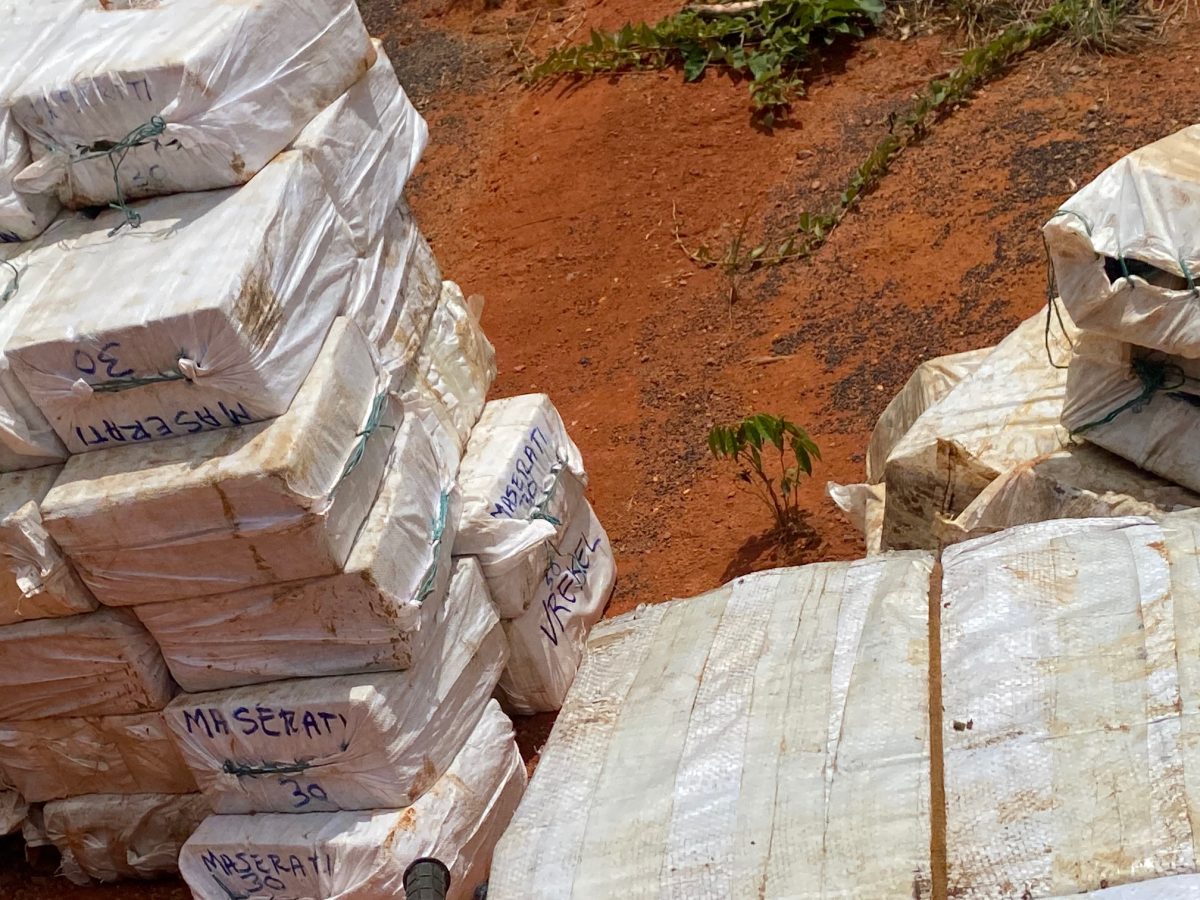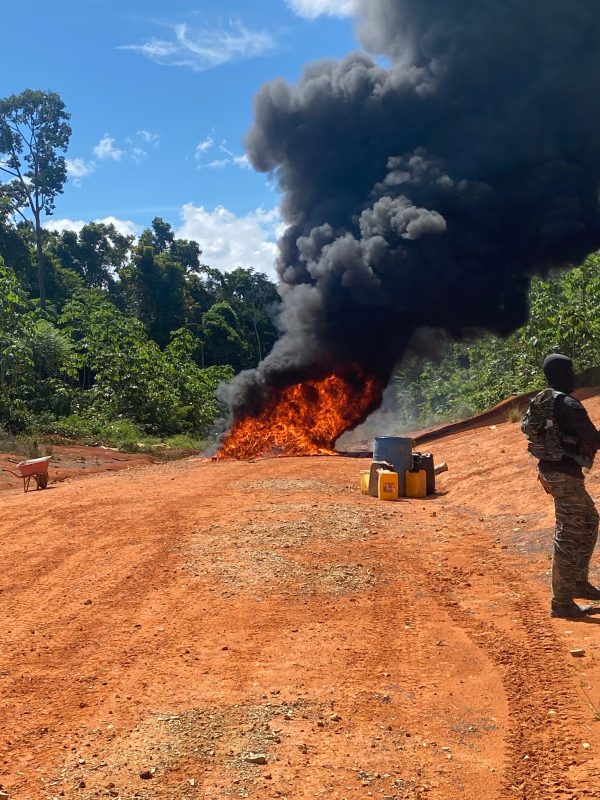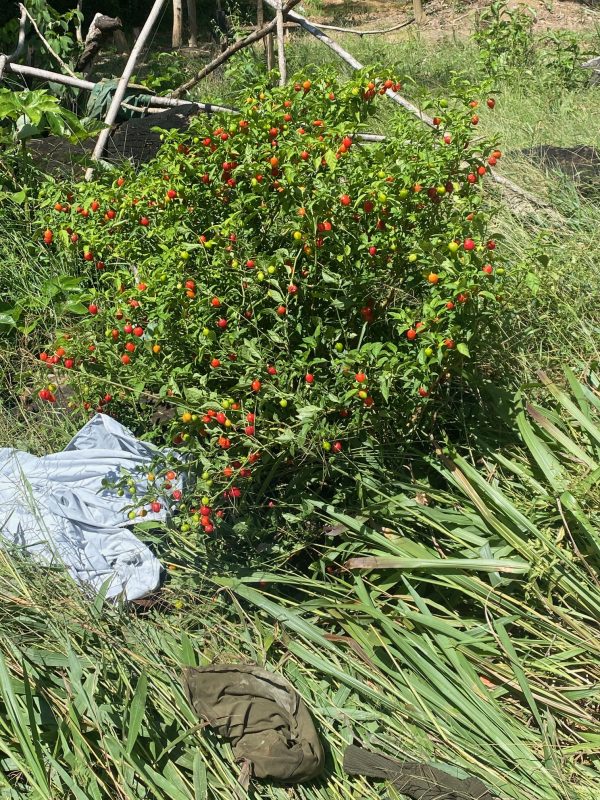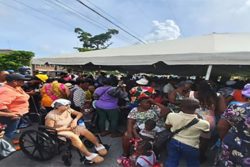As Guyana recorded its largest seizure of cocaine on Saturday in Matthews Ridge, Region One questions remain about where the drug originated, how exactly it was to be transported to its final destination and how long the network has been in place.
The operation was headed by the Customs Anti-Narcotic Unit (CANU) with collaboration from the US Drug Enforcement Administration (DEA) and the Guyana Defence Force (GDF). One suspect was apprehended but his nationality and name are being withheld by the authorities for the while.
Before journalists were transported to the site where the massive amount of cocaine was discovered, they were all clueless as to what the assignment was. The Ministry of Home Affairs facilitated transporting journalists to the location to witness the discovery. Shortly after the aircraft landed at the Matthews Ridge airstrip, a CANU team landed and was dispatched to an unknown location. While journalists were still unaware of the assignment, a taxi driver who transported them into the village commented that it was the first time he had seen CANU in the village.
The reporters were facilitated at a hotel in the village as they awaited further instructions about their assignment in the region. Some three hours later, when it was presumed to be safe, they were transported back the airstrip where they met with a GDF team.
The Guyana Defence Force (GDF) helicopter transported the team to the location and landed on the makeshift illegal airstrip.
As they arrived at the location that was heavily secured by the joint team, the cocaine was being transported on All Terrain Vehicles from the camps. The team that was armed with weapons, surrounded and monitored the location as the media personnel arrived. Some of the men used binoculars while others patrolled the area. The area had to be monitored since some of the suspects had fled into the forest as the joint operation team arrived at the location to conduct the exercise. As a result, the area was treated as an operational zone for security purposes.
“When the team came in, they noticed some persons fleeing into the jungle so we still have to treat is as they are out there. That’s why the security is both for your benefit as well as for the narcotics,” Head of CANU, James Singh told reporters.
The area was surrounded by thick forest while the open area where the airstrip was situated, was covered with loam.
The cocaine was buried in four pits that were five to six feet in depth. When the location was identified they manually dug the area and unearthed the cocaine. The area was camouflaged with leaves, pieces of wood and black tarpaulin. The pits were about 30 minutes walking distance into the jungle. The well-sealed and secured drugs were neatly packaged in parcels that weighed 1 kilogram each. The total amount was written with markers on the bags. The names of persons – presumably to be delivered to – were printed on the packages. Two rifles were also recovered during the exercise.
Pepper and pumpkin
The suspects had makeshift camps and based on observations, they stayed at the location for long periods. The camps housed approximately five to ten persons at the different locations. The suspects even had a little garden with pepper and pumpkin plants.
Post discovery, the team followed intelligence information received in relation to illegal landings of aircraft in the area. Acting on information received, the team ventured into the area a few days ago and managed to highlight the area where the cocaine was buried.
The cocaine was expected to be transported to another country by sea and destined for Europe based on the type of packaging. The operation was conducted in two phases, the first saw the discovery of a quantity of fuel and the follow-up investigation by the GDF special operations section, CANU and DEA led to the successful discovery.
Singh said that CANU and the Joint Services are working together to ensure that Guyana does not become a ‘Narco State’.
To facilitate a thorough investigation, the team did not mention which country the drug came from. Also, the nationality and name of the suspect were not disclosed because of the active investigation. The drug was opened in the presence of reporters and a cocaine field test was conducted on site by a CANU officer. The white powder-like substance was placed in a ziploc bag with three liquid capsules and after bursting them the substance immediately turned blue. According to the test, the drug was classified as high quality cocaine. Small samples were taken as the investigation continues.
The 4.4 tonnes of cocaine is valued at € 176 million or more than US$200 million.
Minister of Home Affairs, Robeson Benn urged residents not to be silent on issues of this nature and to be more cooperative with law enforcement.
Benn further stated that persons who live in the interior are more acquainted with the forest and opined that more cooperation from them will result in better crime fighting and security enhancement. Benn acknowledged that he made a call for persons from the Amerindian communities to join the force.
“The people who live in the interior communities, know the forest and the ways of moving in the forest better.”
Persons being a part of the joint services can help combat issues of this nature and promote safer communities. While the investigation is still ongoing, a lot of information could not be shared, Benn said.
Singh in his remarks said that the team was able to seize the drugs at the right time before they were transshipped to another location.
The airstrip was not gazetted by the government and was illegally built to accommodate small aircraft. According to the CANU head, the cocaine was distributed in four bunkers.
The bunkers were, “basically pits covered with wood, bush and tarpaulins. So, if you’re walking you wouldn’t be able to determine. Officers spent several days in here combing the area and they knew that if it’s not above ground then it’s hidden somewhere underground.”
Stabroek News understands that GDF personnel played an integral role in the operation as it was they who combed the area on notification that there were drugs stashed nearby.
Sheldon Howell, who is acting for Chief of Defence Omar Khan, said that “this seizure is indicative of months and years of intelligence sharing of all the agencies.”
Stating that the “DEA is one of our biggest partners”, he said the army was proud to support special operations and provide logistical and other support. He also praised his ranks and added that the GDF will continue working and investing to actively protect.
Regional Commander, Division # 1, Himnauth Sawh also visited the scene and was briefed by the officials about the discovery.












